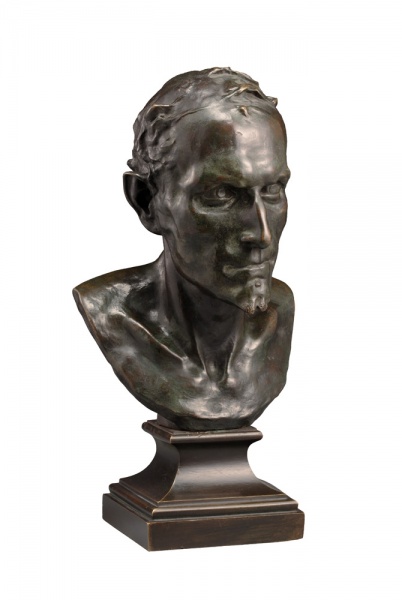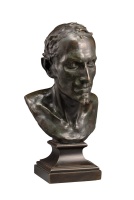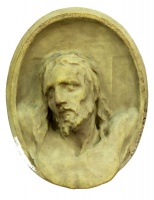

Head of Mephistopheles
| Author: |
Mark Antokolsky (1843–1902)  |
| Created: | 1879 |
| Material: | bronze |
| Dimensions: | 51.50 × 26 cm |
| Signature: | on left shoulder: ANTOKOLSKY |
The figure of Mephistopheles, a fallen angel or demon, originated in German folklore and literature. The most famous depiction of this malign character is in the tragedy Faust by Johann Wolfgang Goethe (1745–1832). Mephistopheles was later portrayed by many writers of the Romantic era from various countries, including Adam Mickiewicz. The character is easily recognisable, not only by the distinct traits of his personality, but also by his angular face, his sharp nose and his pointed beard. The highly talented Jewish sculptor Mark Antokolsky (1843–1902) created a version of Mephistopheles that adheres to this established canon.
One of the most renowned sculptors of the late 19th century, Mark (born Morduk) Antokolsky was born in Vilnius, where Marko Antokolskio Street now honours his memory. He owed his early artistic education to Vilnius, where he received his first lessons, and to Rafal Slizien, a graduate of the Vilnius Art School, who supported his later studies. After completing his education in St Petersburg, he settled in Rome, but returned to Vilnius briefly to marry a local woman. Although he achieved significant professional success in Russia, becoming a professor and a member of the St Petersburg Academy of Fine Arts, he moved to Paris permanently in 1877. He became an honorary member of the Paris, Berlin and Urbino art academies. He died in Hamburg, and was later reinterred in the St Petersburg Jewish cemetery.
Antokolsky’s creative legacy is huge and diverse, including portraits, memorial sculptures and monuments. His monument to Catherine II in Vilnius, completed after his death and dismantled in 1915, deserves a special mention. However, his most famous and widely recognised work is perhaps his depiction of Mephistopheles. The theme of Mephistopheles appeared in his work in the mature stage of his career, after he began creating a figure of Christ in Paris in 1877. Mephistopheles was intended to be the antithesis of Christ. The bronze bust Mephistopheles, cast in 1879, was a study for a future full-figure sculpture. The sculpture became so popular that it was reproduced as an independent work. This version of the work can nowadays be seen in many museums around the world. Antokolsky made a head of Mephistopheles from white marble in 1880, and in 1883 he completed a full-figure marble image of the demon. He wrote in a letter: ‘Mephistopheles is a product of all eras, especially our own. You might say that I invented his presence, that he is just a figment of my imagination, or you could ask where I encountered such a being. It is true that no one has seen him in this form, but we can feel his breath, his huge hand pressing down on our chest, and our inability to cry. In a word, we experience a nightmare.’ Antokolsky expressed skilfully the complex, paradoxical nature of the creature in the demon’s face, which, according to Goethe, is ‘part of that power which eternally wills evil and eternally works good.’
Text author Rūta Janonienė
Between two worlds. The first generation of Litvak artists came up against strong hostility from two sides: because of their desire to paint, they were condemned by their relatives and the dogmas of their own religious community; and because of their different culture, appearance and their poor command of Russian, Polish and French, they were ignored by the world beyond the shtetl. Lazar Krestin, who grew up in a deeply religious family and became a student at the Vilnius School of Drawing, recalled: ‘Dressed as a yeshivah bachur in a long kaftan and a wide-brimmed hat, I must have looked strange to the other students’ (Michael Kaniel, A Guide to Jewish Art, 1989, p. 125). However, this did not stop young people from pursuing careers as artists.
The sculptor Mark Antokolsky, the ‘prodigal son’ of the Jewish community, and the first famous Litvak artist, managed to overcome the opposition of both worlds, and started to spread humanist ideas. He had the idea to depict Mephistopheles in 1874 while working on a sculpture of Christ. Antokolsky wanted to portray a figure with as strong a character as Christ, but with opposing features, so he chose the devil from Goethe’s Faust. He worked for a long time on a figure of Mephistopheles sitting on a rock, and created several studies for the head in plaster (1874), bronze (1876, 1879 and 1883), and marble (1876). Antokolsky wrote: ‘I created my Mephistopheles based on real life and not on Goethe. He is the enemy of mankind, and all that is alive and good’ (МаркАнтокольский. Его жизнь, творения, письма и статьи, 1905, p. 500).
Text author Vilma Gradinskaitė
Source: Law firm Valiunas Ellex art album STORIES OF LITVAK ART (2023). Compiler and author Vilma Gradinskaitė, THE ART OF MATERIALS. Compiler and text author Jurgita LudavičienėExpositions: “Heaven and Beyond. Works of religious art from the collection of Rolandas Valiūnas and the law firm Valiunas Ellex“, 31 May–24 September 2016, Church Heritage Museum, Vilnius (curators Dalia Vasiliūnienė, Skaidrė Urbonienė); "Litvak Artists in Paris", 25 May 2023 – 29 September, Vytautas Kasiulis Museum of Art, Vilnius (curator Vilma Gradinskaitė).








